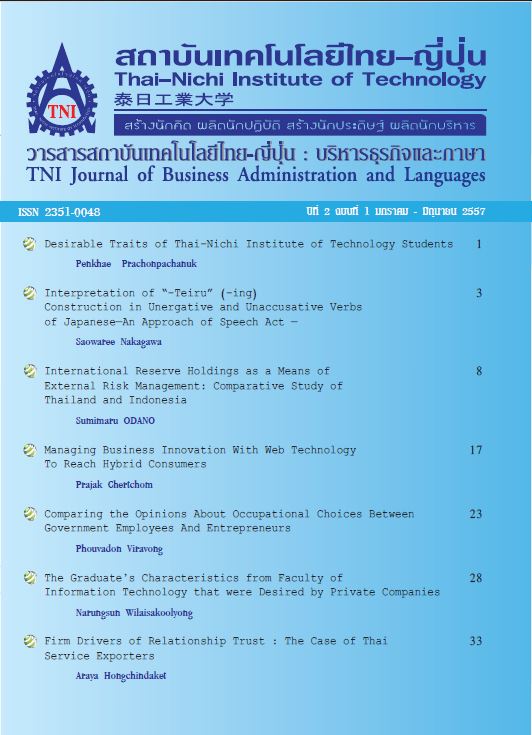Motivation, Attitude and English Learning Behaviours of the low-graded Students
Main Article Content
Abstract
The purposes of this research were as follows: 1) to study motivation, attitude and English learning behaviours of the low-graded students 2) to compare motivation, attitude and English learning behaviours of the low-graded students according to genders and majors based on the students’ grade of ENL-101 from the first semester of 2011 academic year and 3) to compile opinions and suggestions in order to improve teaching-learning methods and techniques to match with the students’ needs.
Research samples were 312 low-graded students at Thai-Nichi Institute of Technology in 2011 academic year, derived through stratified random sampling technique. The instruments used for gathering the data were the rating-scale and open-ended questionnaire. Statistics used for analysing the data were frequency, percentage, mean, standard deviation, t-test, F-test, and content analysis.
Research findings were as follows:
- The low-graded students had a moderate level of motivation, attitude and English learning behaviours. However, when considered in each aspect, it was shown that motivation was at a high level while attitude and English learning behaviours were at a moderate level.
- Students with different genders had no statistically significant differences in motivation, attitude and English learning behaviours in total and in each aspect.
- Students with different majors had statistically significant differences in motivation, attitude and English learning behaviours at .05 level in overall. However, it was found out that there were statistically significant differences on attitude and English learning behaviours at .05 level when considered in each aspect.
- The students gave various suggestions as follows: 1) A pleasure classroom environment should be developed by setting interesting teaching materials as well as the new teaching methods through the application of student-centred approach. 2) English songs and movies should be applied in the classroom for motivating students’ attention. 3) Pair and group discussion based on their areas of interest should be done regularly in order to practice students’ critical thinking and 4) Additional classes for the students who couldn’t catch up with their friends in normal class should be arranged every week. In addition, the teachers should explain the significance of learning English language to the students in order to create their positive attitude and motivation for English learning. Thus, the students may change their learning behaviours in order to achieve their goals.
Article Details
Article Accepting Policy
The editorial board of Thai-Nichi Institute of Technology is pleased to receive articles from lecturers and experts in the fields of business administration, languages, engineering and technology written in Thai or English. The academic work submitted for publication must not be published in any other publication before and must not be under consideration of other journal submissions. Therefore, those interested in participating in the dissemination of work and knowledge can submit their article to the editorial board for further submission to the screening committee to consider publishing in the journal. The articles that can be published include solely research articles. Interested persons can prepare their articles by reviewing recommendations for article authors.
Copyright infringement is solely the responsibility of the author(s) of the article. Articles that have been published must be screened and reviewed for quality from qualified experts approved by the editorial board.
The text that appears within each article published in this research journal is a personal opinion of each author, nothing related to Thai-Nichi Institute of Technology, and other faculty members in the institution in any way. Responsibilities and accuracy for the content of each article are owned by each author. If there is any mistake, each author will be responsible for his/her own article(s).
The editorial board reserves the right not to bring any content, views or comments of articles in the Journal of Thai-Nichi Institute of Technology to publish before receiving permission from the authorized author(s) in writing. The published work is the copyright of the Journal of Thai-Nichi Institute of Technology.
References
Wiriyachitra, A. 2001. A Thai University English Scenario in the Coming Decade. Thai TESOL, 14(1), 4-7.
Narayanan, R., Rajasekaran Nair, N. and Iyyappan S. 2008. Iranian Journal of Language Studies (IJLS), Vol. 2(4), pp. 485-512.
Cook, V.J. (2001). Using the first language in the classroom, Canadian modern language review, 57/3,118.
Dornyei, Z. (2001). Teaching and Researching Motivation. London: Longman.
Thai-Nichi Institute of Technology (2011). TNI student handbook, Bangkok.
Koiso, K. 2003. The characteristics of motivation of Japanese adult English learners. General Social Surveys from JGSS-2003 Data. Retrieved January 15, 2012 from https://jgss.daishodai.ac.jp/japanese/5research/monographs/jgssm5pdf/jgssm5_8.pdf
Qashoa, S. H. H. 2006. Motivation among learners of English in the secondary schools in the eastern coast of UAE. A Master level dissertation. British university in Dubai. Dubai, UAE,
Frith, C. 1997. Motivation to Learn. Retrieved February 10, 2012 from https://www.usask.ca/education/coursework/802papers/frith/motivation.pdf
Schneider, P. H. 2001. Pair taping: Increasing motivation and achievement with a fluency practice. TEST-EJ, Teaching English as a second or foreign language. Vol. 5. No. 2 A-2 September 2001.
Crystal, D. 1992. An Encyclopedic Dictionary of Language and Languages. Cambridge, MA: Blackwell.
Baker, C. 1992. Attitudes and Language. Avon: Clevendon.
Gootman, M. E. 2008. The caring teacher's guide to discipline : helping students learn self-control, responsibility, and respect, K-6, p.36
Brown, H. D. 2000. Principles of language learning and teaching. (4th ed.). New York: Addison Wesley Longman.
Brophy, J. 1986. Classroom Management Techniques. Education and Urban Society, 18/2, p. 182–194.
Markmee, K. and Sheila, T. 2001. Ongoing Teacher Development Initiatives. Thai TESOL, 14(1), 10-13.


